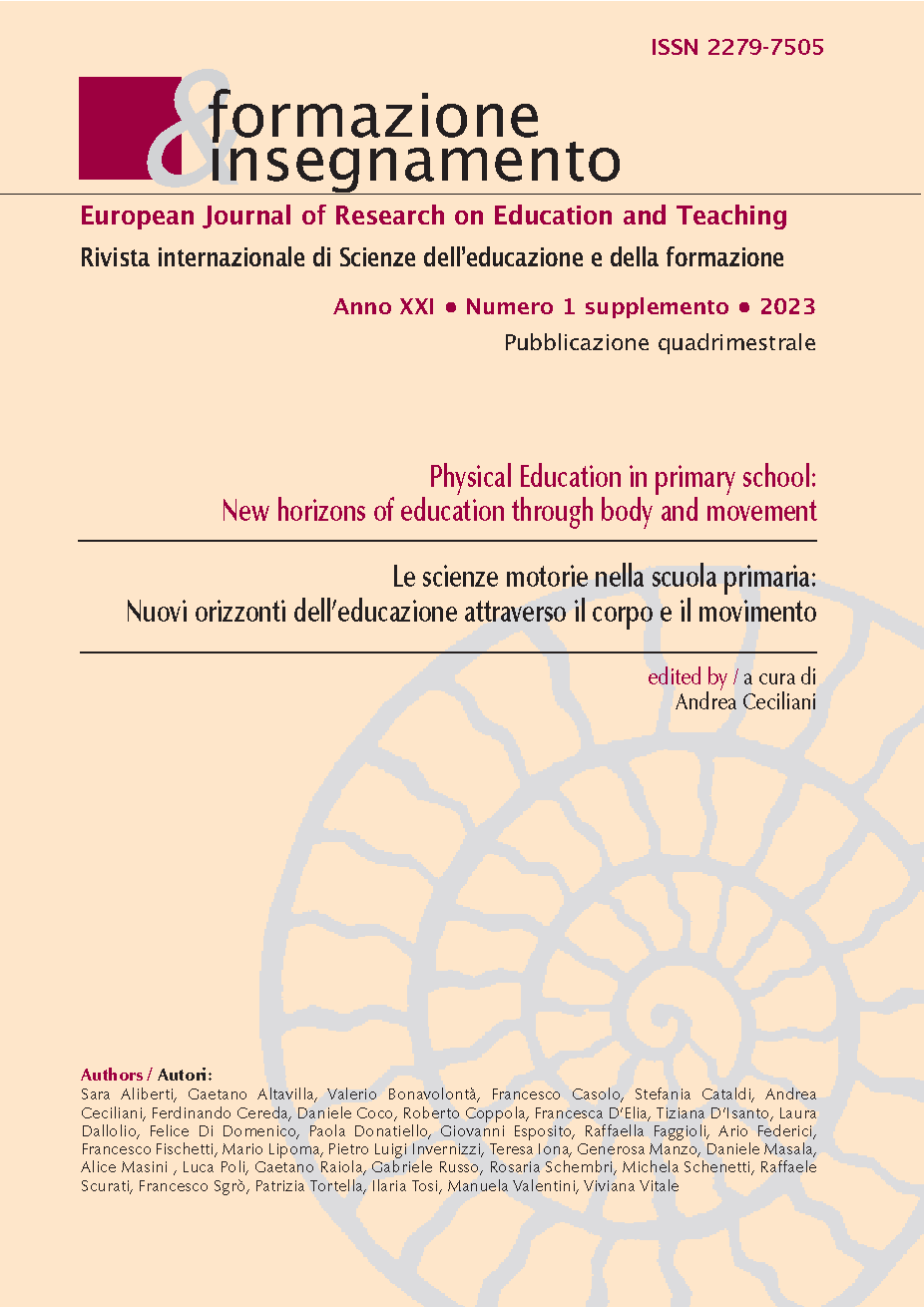Primaria-mente in movimento
DOI:
https://doi.org/10.7346/-feis-XXI-01-23_02Parole chiave:
Educazione all’aperto, Curricolo integrato, Motricità, COVID-19, CorporeitàAbstract
Il nuovo orientamento sociale tende ad isolare all’interno di reti tecnologiche gli attori sociali che sempre più si adattano ad un innaturale e miope sedentarismo. La pandemia COVID-19 non ha che accentuato bisogni e necessità di tutti, specie dei bambini, rimasti esclusi dall’intorno dinamico pro-sociale e ambientale. Con il presente articolo intendiamo porre alcune riflessioni sulle opportunità aperte dalla crisi intesa come “fase decisiva”, dal greco krísis “scelta, decisione”. È il momento di agire e cavalcare l’onda del cambiamento per avvicinarsi a nuovi modelli educativi integrati in grado di porre attenzione sulle potenzialità della motricità, specie all’aperto, legate all’apprendimento, al miglioramento cognitivo, emotivo e fisico. Il corpo, agito e agente primario d’apprendimento, è necessariamente in movimento, involontariamente e ineluttabilmente in incessante ricerca e scoperta di Sé, un Sé posto in relazione al mondo e agli Altri.
Riferimenti bibliografici
(the) Annie E. Casey Foundation (2021). 2021 Kids Count Data Book: 2021 State Trends in Child Well-being. The Annie E. Casey Foundation. Retrieved January 31, 2023, from https://www.aecf.org/resources/2021-kids-count-data-book
Borghi, B. Q. (2015). La lezione di Maria Montessori: una scommessa per il futuro. In M. Baldacci, F. Frabboni, & M. Zabalza (Eds.), Maria Montessori e la scuola d’infanzia a nuovo indirizzo (pp. 47–56). Bergamo: Zeroseiup.
Cocever E., & Canevaro A. (2011). Introduzione. In A. Vasquez, & F. Oury (Eds.), L’organizzazione della classe inclusiva. La pedagogia istituzionale per un ambiente educativo aperto ed efficace (pp. 1–13). Trento: Erickson.
Coyle, K. J. (2017). Digital Technology’s Role in Connecting Children and Adults to Nature and the Outdoors. Virginia: National Wildlife Federation. Retrieved January 31, 2023, from https://www.nwf.org/~/media/PDFs/Kids-and-Nature/NWF_Role-of-Technology-in-Connecting-Kids-to-Nature_6-30_lsh.ashx
Cooper, A. (2015). Nature and the Outdoor Learning Environment:The Forgotten Resource in Early Childhood Education. International Journal of Early Childhood Environmental Education, 3(1), 85–97. Retrieved January 31, 2023, from https://eric.ed.gov/?id=EJ1108430
Dewey, J. (2004). Democrazia e educazione. Milano: Sansoni.
Farné, R., & Agostini, F. (2014). Outdoor education. L'educazione si-cura all'aperto. Bergamo: Edizioni Junior-Spaggiari.
Federici, A. (1993). Attività motorie in ambiente naturale. Idee, proposte ed esperienze. Urbino: Montefeltro.
Federici, A. (2015). Attività motoria in ambiente naturale: una scelta per la vita. RELAdEi, 4(3), 103–115.
Federici, L. (2022). Il videogioco nell’educazione 4.0: così il gaming forma, educa e istruisce. Gaming a scuola. Agenda digitale, 11 Mar 2022. Retrieved January 31, 2023, from https://www.agendadigitale.eu/cultura-digitale/il-videogioco-nelleducazione-4-0-cosi-forma-educa-e-istruisce/
Floridi, L. (2020). Il verde e il blu. Milano: Raffaello Cortina Editore.
Freire, P. (2017). Le virtù dell’educatore. Milano: EDP.
Galeri, P. (Ed.). (2009). Ambientando. Riflessione pedagogica ed esperienze didattiche per l’ambiente. Milano: EDUCatt.
Moliterni, P. (2014). BES e progettazione inclusiva. In P. Gaspari (Ed.), Pedagogia speciale e “BES”. Spunti per una riflessione critica verso la scuola inclusiva (pp. 95–121). Milano: FrancoAngeli.
Guerra, M. (Ed.). (2015). Fuori. Suggestioni nell’incontro tra educazione e natura. Milano: FrancoAngeli.
Le Boulch, J. (1971). Verso una scienza del movimento umano. Roma: Armando.
Lodi, M. (1972). Cipì. Torino: Einaudi.
Lodi, M. (1977). Cominciare dal bambino. Torino: Einaudi.
Lodi, M. (1982). Guida al mestiere di maestro. Roma: Editori Riuniti.
Malaguti, E. (2011). Donne e Uomini con disabilità. Studi di genere, disability studies e nuovi intrecci contemporanei. Ricerche di Pedagogia e Didattica, 6, 1. https://doi.org/10.6092/issn.1970-2221/2238
Malaguzzi, L. (2010). I cento linguaggi dei bambini. L’approccio di Reggio Emilia all’educazione dell’infanzia. Bergamo: Edizioni Junior.
MIUR. (2012). Indicazioni nazionali per il curricolo della scuola dell’infanzia e del primo ciclo d’istruzione. Annali della pubblica istruzione, 88, 3–82. Retreived January 31, 2023, from http://www.comune.torino.it/centromultimediale/01c_I_documenti_pedagogici/documenti_Nazionali_pdf/2012_Indicazioni_Curricolo_Sc_Inf.pdf
Montessori, M. (1950). La scoperta del bambino. Milano: Garzanti.
Mulato, R., & Riegger, S. (2014). Maestra facciamo una pausa?. Bari: La Meridiana.
Okur-Berberoglu, E. (2021). Some Effects of Unstructured Outdoor Plays on a Child: A Case Study from New Zealand. International Electronic Journal of Environmental Education. 11(1), 58–78. Retrieved January 31, 2023, from https://eric.ed.gov/?id=EJ1281430
Scaparro, F. (2002). La famiglia allungata, giovani e sicurezze apparenti. Corriere della sera, 6 aprile, p. 1.
Schwartz, B. (1995). Modernizzare senza escludere. Un progetto di formazione contro l’emarginazione sociale e professionale. Roma: Anicia.
Valentini, M., & Pellegrini, T. (2019). Active video games (AVGS) during childhood: role of the exergames and their impact on physical activity. In M. Lipoma (Ed.), La società per la società: ricerca, scenari, emergenze sull’educazione motoria e sportiva. Lecce: Pensa MultiMedia.
Wenger, E. (2006). Comunità di pratica: Apprendimento, significato e identità. Milano: Raffaello Cortina.
Zhang, T., Moore, W., Gu, X., Chu, T. L., & Gao, Z. (2016). Promoting Children’s Physical Activity. Physical Education: The Role of Active Video Gaming. JTRM in Kinesiology, Jan 2016, 1–13. Retrieved January 31, 2023, from https://eric.ed.gov/?id=EJ1088275
Zhang, T., & Lee, J. (2020). Developing a Motivationally-Supportive Environment to Promote Children’ Physical Activity and Health in Youth Sports During the COVID-19 Pandemic. JTRM in Kinesiology. Sep 2020, 22–24. Retrieved January 31, 2023, from https://eric.ed.gov/?id=EJ1272713
Pubblicato
Come citare
Fascicolo
Sezione
Licenza
Copyright (c) 2023 Manuela Valentini, Paola Donatiello

TQuesto lavoro è fornito con la licenza Creative Commons Attribuzione 4.0 Internazionale.
Formazione & insegnamento è distribuita con la seguente licenza: Attribution 4.0 International (CC BY 4.0).
Per ulteriori dettagli, si rimanda alle Politiche di archiviazione e ai Termini di Copyright e Licenza.





